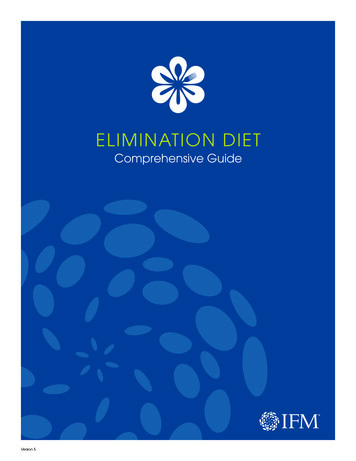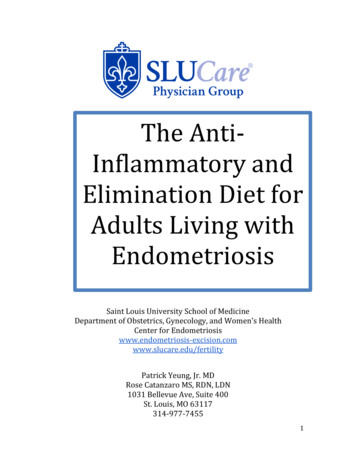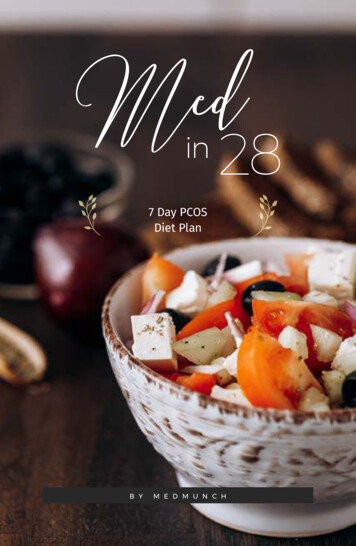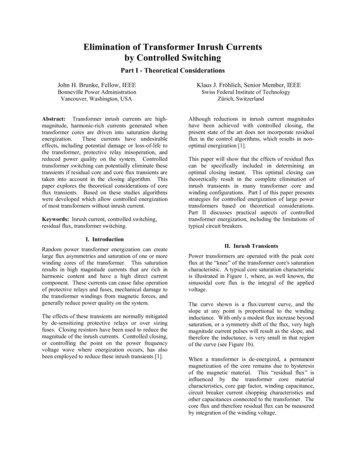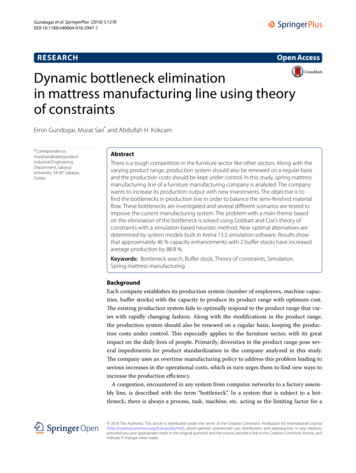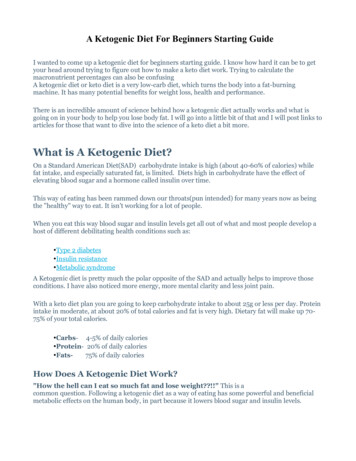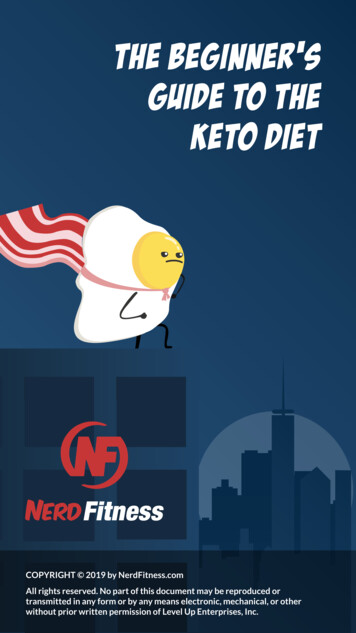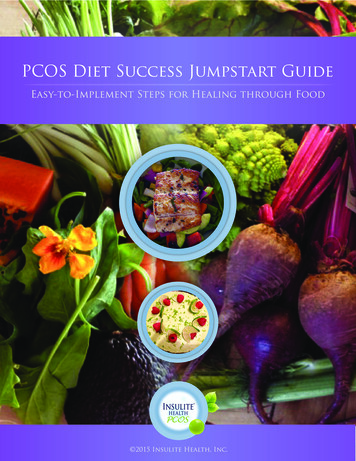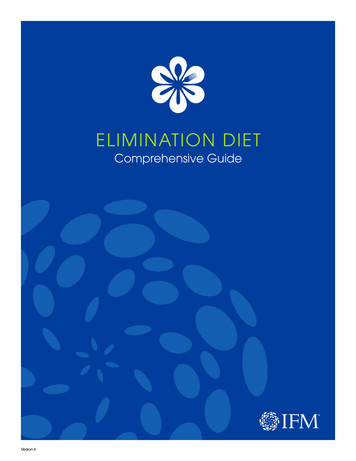
Transcription
ELIMINATION DIETComprehensive GuideVersion 6
Table of ContentsWhy the Elimination Diet?. 3Features of the Elimination Diet. 4Touring Through the Food Plan. 10Getting Started. 17Helpful Hints. 18The Role of Anti-inflammatoryFoods in the Elimination Diet. 19Guidelines forReintroducing Foods. 22Frequently Asked Questions. 25Resources and Tools for Success. 29 2016 The Institute for Functional Medicine
Why the Elimination Diet?Symptoms and conditions that have failed to respond to conventional medical therapy may resolve when a personfollows the IFM Elimination Diet. Specific foods or foods eaten frequently may be related to a long list of healthconditions, including digestive problems, headaches, chronic sinus drainage, low energy, depression, mood swings,eczema, skin irritations, joint aches, asthma, weight gain, and others. People may suffer from these symptoms forlong periods of time without realizing that they can be connected to the foods they are eating. Often it isn’t untila food is removed that the connection between symptoms and foods can be made. The Elimination Diet removescommon foods that may be causing symptoms and, with reintroduction, helps patients identify the foods that maybe triggering their symptoms.Often, symptoms that have failed to respond to conventional medical therapy will resolve by following theElimination Diet. After the initial period of eliminating foods, many chronic symptoms should improve or disappear.When the burden on the immune system is decreased, the body has an opportunity to heal. During the eliminationperiod, it is important to make sure that the diet is still enjoyable and nutrient-dense. The road to optimum healthstarts with decreasing the burden on the immune system while ensuring adequate nutrition.After completion of the three-week Elimination Diet, patients will undergo a food reintroduction process. The goalis to expand the variety of healthy foods available to an individual for daily intake. Reintroduction involves addingback one food at a time and observing whether that food is associated with negative symptoms. Foods that continueto provoke symptoms (physical, mental, and emotional) are avoided for an additional three to six months, at whichtime reintroduction is attempted again. Once the gut is healed, many foods that initially caused sensitivities maybe reintroduced into a meal plan without symptoms. Healing the gut, and being able to successfully reintroducefoods is important, as eating the same few foods day after day does not provide the body with the full array ofphytonutrients necessary for overall health. A diet with a large diversity of foods helps ensure that the body getsessential nutrients and is especially important for those who have digestive issues.IFMnElimination Diet Comprehensive Guide 2016 The Institute for Functional Medicine3
Features of the Elimination DietnMany people with food sensitivitiesdon’t realize how bad they feel, or that particular foods arethe culprit, until the foods that trigger a reaction are removedfrom the diet. Food reactions are frequently overlooked asa contributor to chronic health issues. Some reactions areconsidered to be food allergies, which cause severe symptomsimmediately after a trigger food is eaten. Some reactions maybe delayed by hours or even days; this type of adverse foodreaction is referred to as a food sensitivity. Food sensitivitiesare usually the result of an imbalance in the gastrointestinalsystem that affects the immune system Food intolerances canbe the result of reactions to certain chemicals in food (e.g.,MSG or histamine). They can also occur when a person lacksan enzyme necessary to digest the food, such as lactase whichis needed to digest milk products.Identifies food triggers:These adverse food reactions are common when the same foods are eaten day after day, resultingin greater sensitization to these foods. If a person keeps eating the foods they are sensitive to,digestion and absorption may be impaired. Additionally, those with weakened immune systemsmay be more prone to food sensitivities. The Elimination Diet is a useful tool for diagnosingadverse food reactions, whether true allergy, intolerance, or sensitivity.The Elimination Diet guides individuals to include or exclude certain foods. Those foods thatare avoided are those generally eaten often, even several times daily, including wheat and othergluten-containing grains, dairy, refined and artificial sweeteners, corn, beef, pork, eggs, and soy.Because wheat, corn, and soy are commonly added to many processed food products, we areoften not aware of the extent of these foods in our diets. Fast foods and other highly processedprepared foods contain a variety of pro-inflammatory chemicals that add to the toxic burden onthe liver, so these are also avoided.nFood reactions of any type can trigger low-grade inflammatory reactionsin the gut, making the intestinal wall more porous and exposed to the influx of large, undigestedfood particles into the blood (a condition referred to as “leaky gut”). This breakdown of theintestinal barrier can allow other substances like bacteria, chemicals, and yeast to leak fromthe intestine into the bloodstream, further stimulating the immune system and causing moreinflammation. Just as food reactions can lead to leaky gut, the reverse is also true; leaky gut cansignificantly increase the development of food sensitivities. Removing problem foods decreasesinflammation and helps calm the immune response.Reduces inflammation:The Elimination Diet helps to reduce inflammation by promoting the ingestion of antiinflammatory foods. Over time, these foods, combined with the elimination of common triggerfoods, causes inflammation to subside and helps the gut to heal. This allows the immune systemto begin to work properly again. It also fosters an improved immune response to airbornecontaminants and allergens, industrial contaminants, viruses, parasites, and bacteria—whichmeans that individuals will be less affected by toxins and infections, making them sick less often.IFMnElimination Diet Comprehensive Guide 2016 The Institute for Functional Medicine4
Features of the Elimination DietThe intestinal lining is made of cells that replace themselves approximately every two to fourdays. This means that, in the span of a single week, every cell in the intestinal lining is brokendown or sloughed off and a new cell grows to take its place. Removing from the diet potentiallyharmful foods and those that cause inflammation, while at the same time supplying the bodywith healthy, anti-inflammatory whole foods (especially those containing healthy fats, fiber, andan array of phytonutrients) makes this newly-formed gut tissue stronger and healthier.nMuch of one’s overall health is determined by the health ofthe gut. More than 70% of the immune system is clustered around the digestive tract. The gutimmune system is constantly assessing things that are ingested or inhaled into the digestive tract.The way the immune system responds is impacted by the flora that inhabit the gut. The normalflora, also referred to as the microbiome, help regulate the immune response.Supports healthy microbiome:When the gut is inflamed, the balance of beneficial versus non-beneficial microbes is thrown off.This results in improper stimulation of the immune response and can cause adverse symptoms.Providing essential nutrients for healing is a critical factor in creating a healthy microbiomeas well as a healthy immune response. Eliminating certain foods decreases inflammation,which allows the gut, and ultimately the immune system, to heal. Additionally, a healthy gutmicrobiome can be rebuilt by eating healthy whole foods, especially those high in protein,phytonutrients, probiotics, and prebiotics. These foods are the basis of the Elimination Diet.nDairy-free, gluten-free: Because of their frequentassociation with adverse food reactions, dairy productsare omitted on the Elimination Diet. Some of the troublewith dairy is due to the presence of lactose, a milk sugar.The lactose present in fresh milk and in many othercommercially available dairy products can cause painfulgas, bloating, and digestive upset, especially in those wholack adequate lactase, the enzyme needed to properlydigest lactose. It is estimated that somewhere between25% and 90% of the world’s population is lactase-deficientto some extent.Fermented dairy products like yogurt and sour cream arelargely free of lactose, but these products contain casein, amilk protein that can also cause adverse reactions. Thereare different types of casein (A1 and A2 beta casein)in milk, depending on the type of cow (e.g., Holstein,Jersey, or Guernsey), and this too may impact tolerance.However, researchers are continuing to investigate therole these casein proteins play in allergies, intolerances,and intestinal permeability. Until science clarifies thedebate surrounding the different types of casein, all dairyproducts are avoided while on the Elimination Diet.IFMnElimination Diet Comprehensive Guide 2016 The Institute for Functional Medicine5
Features of the Elimination DietAlso eliminated on this plan is gluten. Gluten is a sticky, water-soluble family of proteins foundin a few key grains (barley, rye, and wheat) and associated grain products (breads, cereals, crackers,pastas, etc.). Toxic proteins in gluten called gliadins can break down the microvilli (finger-likeprotrusions of intestinal cells) in the small intestine. This deterioration can cause leaky gut, foodallergies, sensitivities, intolerances, and other digestive disturbances or autoimmune conditions.Some people respond well after gluten is removed from the diet, even in the absence of the usualgastrointestinal symptoms associated with gluten intolerance. A growing body of evidence linksgluten exposure to neurological symptoms including depression, fatigue, migraines, and brain fog,which may seem to be unrelated to food intake. However, given that many neurotransmitters areproduced in the gut, the link between overall gut health and brain health is undeniable.Examples of dairy products and grains that are avoided on the Elimination Dietare shown in the table below. Note that all products containing these foods asingredients are also excluded from the plan.Dairy ProductsGrains (gluten-containing)ButterBarleyCheese (all)BulgarHeavy creamOats*Half and halfRyeIce creamSeitanKefirTriticaleMilkWheat (farro, kamut, spelt,and all other varieties)Sour creamYogurt*Oats, even those that are labeled as gluten-free, are often processed in the same facilityas gluten-containing grains and can become contaminated with gluten during processing.Additionally, even certified gluten-free oats that are never exposed to gluten can causesymptoms in some patients with celiac disease and gluten intolerance, as the proteinstructure found in oats is similar to that of gliadin. For this reason, patients should follow theirpractitioner’s advice when reintroducing oats back into their diets.IFMnElimination Diet Comprehensive Guide 2016 The Institute for Functional Medicine6
Features of the Elimination DietnThe Elimination Diet contains a broad variety of colorfulvegetables and fruits. These plant foods provide a complex array of essential nutrients, calledphytonutrients and antioxidants, that promote healing and detoxification in the gut, liver,and kidney. Antioxidants provide protection against free radicals (molecules that can damagecells), which often form during detoxification. Plant foods help alkalinize the body, improvingexcretion of toxins by the kidneys. Phytonutrients also play an active role in improving the stressresponse and reducing inflammation.Phytonutrients to heal the gut:Colorful fresh fruits contain phytonutrients, but they also have natural sugar. In general, our tastebuds are more responsive to sweet foods, which often leads to people eating more fruits thanvegetables. This food plan emphasizes incorporating more vegetables than fruits in the diet inorder to avoid excessive intake of natural sugars.nReduces toxic burden: Our food supply has become compromisedby the addition of artificial colorings, flavorings, additives, andpreservatives, not to mention the pesticides, insecticides, andherbicides in conventionally grown produce, whole grains, nuts,seeds, and legumes. Perhaps one of the biggest nutritional burdensin our society is the amount of sweeteners in highly processedprepared foods. Eating a “cleaner” diet by avoiding problem foodscan help increase the liver’s ability to eliminate toxins. In addition toavoiding potentially reactive foods and products that may be toxic,the Elimination Diet promotes the consumption of organic foodsto lower the toxic burden in the body. It also encourages grass-fed,pasture-raised, and free-range sources of animal protein, as they arehigher in healthy omega-3 fatty acids than their corn-fed and cagedcounterparts.A person’s toxic burden is a result of three main factors:nnnIFMnGenetics: predisposition for effective production of detoxification enzymes needed to processtoxic compounds or substrates is unique and depends on familial influence.Toxins: exposure can occur through both internal and external sources.Diet: a diet rich in detoxification nutrients and phytonutrients will promote the body’sability to eliminate toxic substances.Elimination Diet Comprehensive Guide 2016 The Institute for Functional Medicine7
Features of the Elimination DietWhile there is great emphasis in this food plan on reducing the intake of toxins of all kinds, theelimination of accumulated toxins present in the body is equally important. Several metabolicpathways in the body are responsible for converting toxins into chemical compounds, allowingtoxin elimination primarily through urine, stool, and sweat. Many different nutrients are requiredto fuel the process of detoxification. A shortage or deficiency of any one of them could result inan increased toxic load or toxic burden. Lowering the body’s toxic burden by eating clean, wholefoods will assist the liver in converting toxins stored in the body’s fat cells into intermediatemetabolites that can then be excreted through the urine and stool. Intake of high-fiber foodswith adequate hydration is essential to ensure elimination of these transformed toxins.nNo calorie restriction: WeightnPromotes body awareness to food: AfterIFMloss is not a goal of this food plan, but it may (or may not)happen when the body comes back into balance. As a result, calorie control and inclusion ofspecific food groups are optional. Thus the Elimination Diet is not as restrictive as some dietaryregimens. However, it is essential that patients eat only the foods that appear on the EliminationDiet food list.the initial phase of the Elimination Diet, the person‘challenges’ certain foods during a reintroduction phase. This helps identify any problem foodsthat continue to cause symptoms. During the reintroduction phase, many patients develop anincreasing awareness of foods that trigger symptoms in the body. Being on the EliminationDiet for even a few weeks can lead to changes in the taste buds and a greater level of sensitivityabout which foods cause changes in the body. Symptoms that are currently a problem are likelyto improve during the Elimination Diet, although there can be an initial period of worseningsymptoms. As the avoided foods are carefully brought back into an eating plan, patients cansee what foods may trigger the symptoms experienced prior to the Elimination Diet. Overall,patients will notice that they are much more in touch with their body’s responses to foods afterthe Elimination Diet.nElimination Diet Comprehensive Guide 2016 The Institute for Functional Medicine8
Features of the Elimination DietN DIET FEOITATNAURIMESILEINFO RM ATIONnElimination Diet Comprehensive GuidePhto y to nutHea l r ie ntsth eGutCOE N E R GYso t e e ssP r o m re nwadBo dy Aooto FNNECTIONMEDICINENoRe Ca lo r ies tr ic ti onIFMSupports HeMicrobio althm ye,FreeiryeDa en-FreutGlIdenFood tifiesTriggerscesudRe mationamflInescuenReddrBucixTo 2016 The Institute for Functional Medicine9
Touring Through the Food PlanThe two-page Elimination Diet Food Plan provides a snapshot of the foods that are available to choose from everyday. A general description of food categories is helpful before beginning the process of avoiding foods that may becausing problems.VEGETABLES Non-starchyElimination Diet Food PlanPROTEINSProteinsDAIRY Lean, free-range, grass-fed, organically grownanimal protein; non-GMO, organic plant protein;and wild-caught, low-mercury fish preferred.Unsweetened, organic preferredAnimal Proteins:Fish: Halibut,herring, mackerel,salmon, sardines,tuna, etc.–1 ozMeat: All wild game,buffalo, elk, lamb,venison–1 ozPoultry (skinless):Chicken, Cornishhen, turkey–1 ozKefir: Coconut(plain) –4-6 ozMilk: Almond,coconut, flaxseed,hazelnut, hemp,rice–8 ozPlant Protein:Spirulina–2 TProtein Powder:Check label for# grams/scoop(1 protein serving 7 g)Hemp, pea, rice1 serving as listed 35–75 calories, 5–7 g protein, 3–5 gfat, 0–4 g carbsAverage protein serving is 3–4 oz (size of palm of hand).EliminateBeef/veal, canned meats, cold cuts, eggs, frankfurters,pork, shellfish, whey, soy (miso, natto, tempeh, tofu,textured vegetable protein)LEGUMESProteins/CarbsServings/dayOrganic, non-GMO preferredBean soups–¾ cDried beans, peas, orlentils (cooked)–½ cFlour, legume–¼ cGreen peas(cooked)–½ cHummus or otherbean dip–⅓ cRefried beans,vegetarian–½ cYogurt: Coconut(cultured) –4-6 ozEliminateButter, cheese, cottage cheese, cream, frozen yogurt,ice cream, milk, non-dairy creamers, soy milk, yogurt(dairy and soy), wheyProteins/FatsServings/dayUnsweetened, unsalted, organic preferredAlmonds –6Brazil nuts–2Cashews –6Chia seeds–1 TCoconut (dried)–3 TFlaxseed (ground)–2To Hazelnuts–5o Hemp seeds–1 TMacadamias–2-3ooooooFATS & OILSFatsServings/day1 serving 25–90 calories, 1–9 g protein, 1–4 g carbs(nutritional values vary)NUTS & SEEDSCarbso Nut and seedbutters–½ To Pecan Halves–4o Pine nuts–1 To Pistachios–16o Pumpkin seeds–1 To Sesame seeds–1 To Sunflower seeds –1 To Walnut halves –41 serving 45 calories, 5 g fatEliminateMinimally refined, cold-pressed, organic,non-GMO preferredo Avocado –2 T or⅛ wholeo Coconut milk,regular (canned)–1½ To Coconut milk, light(canned)–3 To Ghee/clarified butter(grass-fed)–1 to Olives: Black,green, kalamata–8o Oils, cooking:Avocado, coconut,grapeseed, olive(extra virgin), ricebran, sesame–1 to Oils, salad:Almond, avocado,flaxseed, grapeseed,hempseed, olive(extra virgin),pumpkin, safflower(high-oleic),sunflower (higholeic), sesame,walnut–1 to Prepared saladdressing withacceptable oils–2 T1 serving 45 calories, 5g fatEliminateButter, corn oil, cottonseed oil, margarine/spreads,mayonnaise, peanut oil, shortening, soybean oilKEYHigh HistamineNightshadesFermented FoodsArtichokeArugulaAsparagusBamboo shootsBeets (cubed)Bok choyBroccoflowerBroccoliBrussels sproutsCabbageCarrotsCauliflowerCeleriac rootCeleryChard/Swiss chardChervilChivesCilantroCucumbersDaikon ables:Kimchi, pickles,sauerkraut, etc.GarlicGreen beansGreens: Beet, collard,dandelion, kale,mustard, turnip, etc.HorseradishJicamaKohlrabiLeeksLettuce, allMicrogreensMushroomsOkraOnionsParsleyPeppers, allRadicchioRadishesSalsaSea vegetablesScallionsShallotsSnap peas/snow peasSpinachSprouts, allSquash: Delicata,pumpkin, spaghetti,yellow, zucchini, etc.TomatoTomato juice –¾cTurnipsVegetable juice–¾ cWater chestnutsWatercress1 serving ½ c, 1 c raw greens 25 calories, 5 g carbsNotes: Nutritional amounts are based on average values for thevariety of foods within each food category.Mixed nuts (with peanuts), peanuts, peanut butterDietary prescription is subject to the discretion of thehealth practitioner.1 serving 90–110 calories, 3–7 g protein, 0 fat, 15 g carbsVEGETABLES StarchyServings/dayServings/dayAcorn squash(cubed)–1 cButternut squash(cubed)–1 cPlantain–⅓ c or½ wholePotato: Purple,red, sweet, white,yellow–½ medCarbso o o o o o oPotatoes (mashed,made with nondairy milk)–½ cRoot vegetables:Parsnip, rutabaga–½ cYam–½ med1 serving 80 calories, 15 g carbsEliminateUnsweetened, sprouted, organic preferredAmaranth–¾ cBrown rice cakes–2Buckwheat/kasha–½ cCrackers: (nut, seed,rice)–3-4Flours for baking:Arrowroot, sorghum,tapioca–3 TMillet–½ cOats: Rolled,steel-cut–½ cQuinoa–½ cRice–⅓ cTeff–¾ cAll grain servings arefor cooked amounts.EliminateCarbsBarley, corn, emmer, farro, kamut, rye, spelt,triticale, wheatBEVERAGES, SPICES & CONDIMENTSServings/dayUnsweetened, no sugar addedApple–1 smApplesauce–½ cApricots–4Banana–½ medBlackberries–¾ cBlueberries–¾ cDried fruit(no sulfites)–2 TFigs–3Grapes–15Grapefruit–½ medJuices (diluted)–½ cKiwi–1 medKumquats–4Lemon–1Lime–1CarbsServings/day1 serving 75-110 calories, 15 g carbsCorn, Potato (if avoiding nightshades)FRUITSGLUTEN-FREE GRAINSMelon, all–1 cMango–½ smNectarine–1 smOrange–1 medPapaya–1 cPeach–1 smPear–1 smPersimmon–½Pineapple–¾ cPlums–2 smPomegranate seeds–½ cPrunes–3 medRaisins–2 TRaspberries –1 cTangerines–2 smUnsweetened, no sugar addedFiltered waterSparkling/mineralwaterUnsweetenedcoconut waterGreen teaFresh juiced fruits/vegetablesHerbs and Spices, allCondiments:Mustard, vinegars– use sparingly, suggest1 T or less per serving1 serving 60 calories, 15 g carbsEliminateCitrus fruits (if directed by your healthcare provider)Organic, non–GMO fruits, vegetables, herbs and spices preferredKEYHigh HistamineNightshadesFermented FoodsEliminateSoybean products (edamame, miso, soy sauce, tamari,tempeh, tofu, soy milk, soy yogurt, textured vegetable protein) 2016 The Institute for Functional MedicineVersion 8 2016 The Institute for Functional MedicineIn order to achieve the therapeutic effects of the Elimination Diet, it is important to know whichfoods to avoid and which foods are okay to eat. The table below provides a summary.Table of foods to remove/foods to eat:Foods to AvoidFoods to Eatn Alcoholn Dairy alternativesn Beefn Fishn Chocolaten Fruits (only those specifically listed)n Coffee, soft drinks, tean Game meatsn Cornn Gluten-free whole grains (amaranth,buckwheat, millet, quinoa, rice, teff,etc.)n Dairy productsn Healthy oilsn Eggsn Legumes (except soy, peanuts)n Gluten-containing grains (all varieties ofn Nuts (except peanuts)barley, rye, spelt, wheat)n Peanutsn Poultryn Porkn Seedsn Processed meatsn Vegetablesn Shellfishn Soy and soy productsn Sugar (white sugar, high-fructose cornsyrup, brown sugar, sucrose, etc.)IFMnElimination Diet Comprehensive Guide 2016 The Institute for Functional Medicine10
Touring Through the Food PlanProteinProtein is an essential cornerstone of optimal nutrition. It performs multiplefunctions in the body, such as helping to stabilize blood sugar levels, which in turnkeeps hunger and cravings at bay. Additionally, the human body cannot effectivelyeliminate toxins without amino acids—the building blocks of protein—thatbind transformed toxins in the liver and help the body excrete them. Thus, it isextremely important to include some protein in every meal or snack.The Elimination Diet offers different sources of animal and plant proteins from which to choose. As with the otherfood categories, quality is of utmost importance. High-quality proteins include lean, pasture-raised, grass-fed, organic,and non-genetically modified (GMO) sources. Options include low-mercury fish like halibut, herring, mackerel,salmon, sardines, and tuna. Wild-caught, sustainable fish choices are preferred, as some farmed fish may containhormones and harmful chemicals. Other protein options include wild game (buffalo, elk, lamb, venison) and poultry(chicken, Cornish hen, turkey).Vegetarian protein choices include spirulina, legumes, lentils, peas, and select proteinpowders (hemp, pea, and rice).LegumesLegumes are a perfect source of quality protein and complex carbohydrates, which givea sense of fullness and stabilize blood sugar. At least one serving of legumes on a dailybasis in soup or as cooked beans, dips, or hummus is recommended.Dairy AlternativesDairy products are not included in the Elimination Diet, as dairy is often a culprit ingastrointestinal symptoms. Additionally, the risk of toxin and hormone contaminationis high with many commercially available dairy products. There are several dairyalternatives available in this food plan, mostly in the form of milks made from nuts.Dairy substitutes like coconut (boxed variety), almond, flaxseed, or hazelnut milkoften contain added sweeteners or gums, so it is important to read food labels beforepurchasing. Unsweetened coconut kefir is included in the food plan because of itsprebiotic and probiotic potential, which may help improve gut health and aid intoxin removal.IFMnElimination Diet Comprehensive Guide 2016 The Institute for Functional Medicine11
Touring Through the Food PlanNuts & SeedsA variety of nuts and seeds is included in the Elimination Diet. They can be added to meals for a nutrient and flavorboost—perhaps sprinkled on top of salads or vegetable dishes—and make a great snack choice. Eating a handful of nutseach day has been shown to reduce the risk of chronic disease. It is recommended that at least 1 to 2 servings of nuts beeaten every day. Raw, unsalted nuts instead of nuts roasted in oil are preferred. Flaxseeds and hemp seeds can be groundand stirred into smoothies or sprinkled on salads. Additionally, nut butters like almond butter, cashew butter, and tahini(sesame seed butter) can be used as condiments, spread on fruit, or drizzled over vegetables.Nuts can often be the source of food allergies, so a Functional Medicine practitioner mayrecommend a personalized variation of this food plan that excludes nuts if allergies or sensitivitiesare known or suspected.Fats & OilsA large selection of fats and oils can be used for salad dressings and cooking while followingthe Elimination Diet. Approved choices are minimally refined, cold-pressed, organic, nonGMO fats and liquid oils, as these will be the best quality. Consuming these high-qualityfats on a daily basis is recommended for reducing inflammation, stabilizing blood sugarlevels, and minimizing sugar cravings. A Functional Medicine practitioner may prescribespecific amounts to meet an individual’s nutritional needs.Extra-virgin olive oil is associated with healthy cholesterol levels. Research suggests that consuming minimally processedextra-virgin olive oil provides the greatest health benefits by increasing HDL (healthy cholesterol) and decreasingoxidative damage. The health benefits of olive oil are also found in whole olives, which are included in this category.Coconut-based fats, particularly coconut oil, are rich in medium-chain fatty acids(MCFAs) that help restore gut health. MCFAs are absorbed directly into the liningof the small intestine and sent straight to the liver for energy production, or areconverted into ketone bodies, an important source of energy for the brain. In addition,these fats have antioxidant and antimicrobial properties that help support the immunesystem. They also offer antifungal, antibacterial, and antiviral benefits. Because MCFAsare extremely easy for the body to burn for calories, there is less potential for themto be stored as fat. Canned coconut milk is included in the ‘fats and oils’ category because it is predominantly a sourceof fat, unlike boxed coconut milk, which is primarily a source of protein and carbohydrates. However, most metal cansare lined with a toxic material, bisphenol A (BPA), so look for BPA-free cans when buying canned coconut milk, orpurchase the boxed version instead.Another high-quality fat included in the Elimination Diet is avocado oil. Unlike manyother plant-based oils that are pressed from the plants’ seeds, avocado oil is pressed fromthe fruit itself. In addition to being good sources of high-quality, healthy fat, avocadosand their oils are nutrient-dense and antioxidant-rich. One half of an average avocadocontains more potassium than a banana, in addition to other important nutrients likemagnesium, folate, choline, and glutathione.IFMnElimination Diet Comprehensive Guide 2016 The Institute for Functional Medicine12
Touring Through the Food PlanGhee, or clarified butter, is also included in this category. While ghee is technically a dairyproduct, all milk proteins are removed in the process of making it. Ghee is primarily composedof short-chain fatty acids (SCFAs), which are easily digested by the body and are thoughtto stimulate the secretion of stomach acids to help with digestion. Ghee also has a highconcentration of butyric acid, which contains antiviral properties and helps break down foodfor energy. The butter used for making ghee should come from grass-fed cows and be certifiedas organic.Sesame oil is included in the Elimination Diet for its medicinal role in liver function, as it assists in the healthyprocessing of fats and reduces inflammation. Other fats included in this category include almond oil, flaxseed oil,hempseed oil, and walnut oil.Fats and liquid oils can be damaged by heat, light, and oxygen. Liquid oils should be stored intightly-sealed, tinted glass (not plastic) containers and kept in a cool, dark area. They should not bekept near the stove and should be discarded if they smell rancid.Non-Starchy and Starchy VegetablesThe Elimination Diet emphasizes eating plenty of vegetables. Ideally, it is best to get10–12 servings of vegetables per day. (A serving is ½ cup of most vegetables or 1 cup ofraw leafy greens.)Green vegetables, especially members of the cabbage family, are particularly nutritiousfor those on the Elimination Diet. However it is important to eat a
The Elimination Diet helps to reduce inflammation by promoting the ingestion of anti-inflammatory foods. Over time, these foods, combined with the elimination of common trigger foods, causes inflammation to subside and helps the gut to heal. This
